
Walter – III – Mozart Symphonies n°38 & 41 WPO – Sinfonia Concertante K.364 NYPO John Corigliano & William Lincer
Mozart
Symphonie n°38 K.504 WPO Musikvereinsaal 18 Dezember 1936
Symphonie n°41 K.551 WPO Musikvereinsaal 11 Januar (Jänner) 1938
Source: 33t. Angel Japan « The Art of Bruno Walter with WPO »
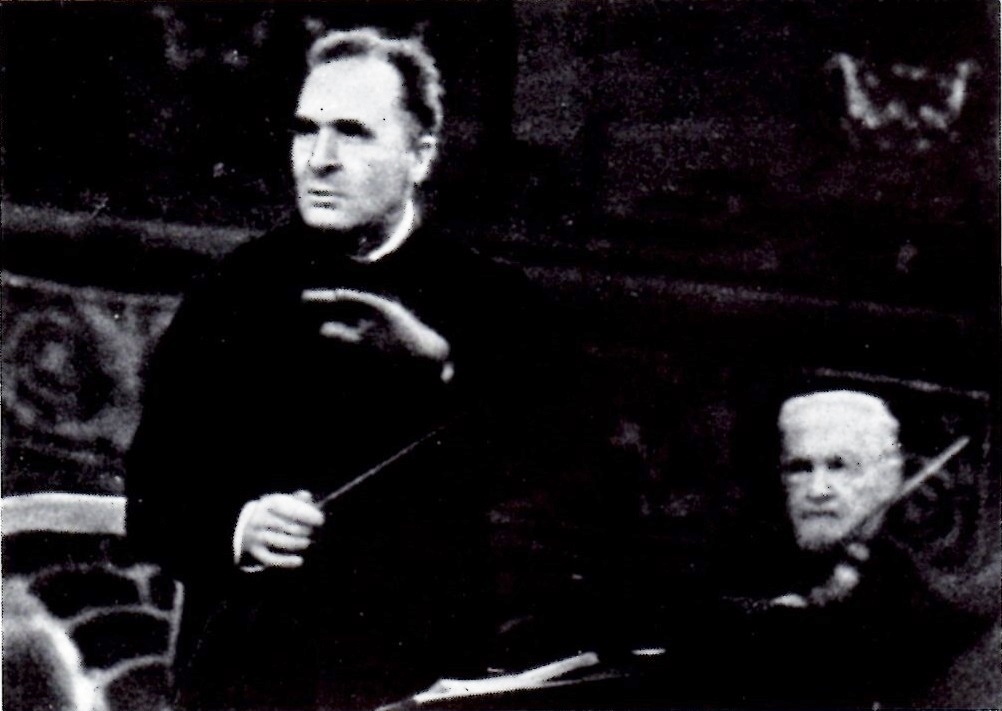
Bruno Walter & Arnold Rosé
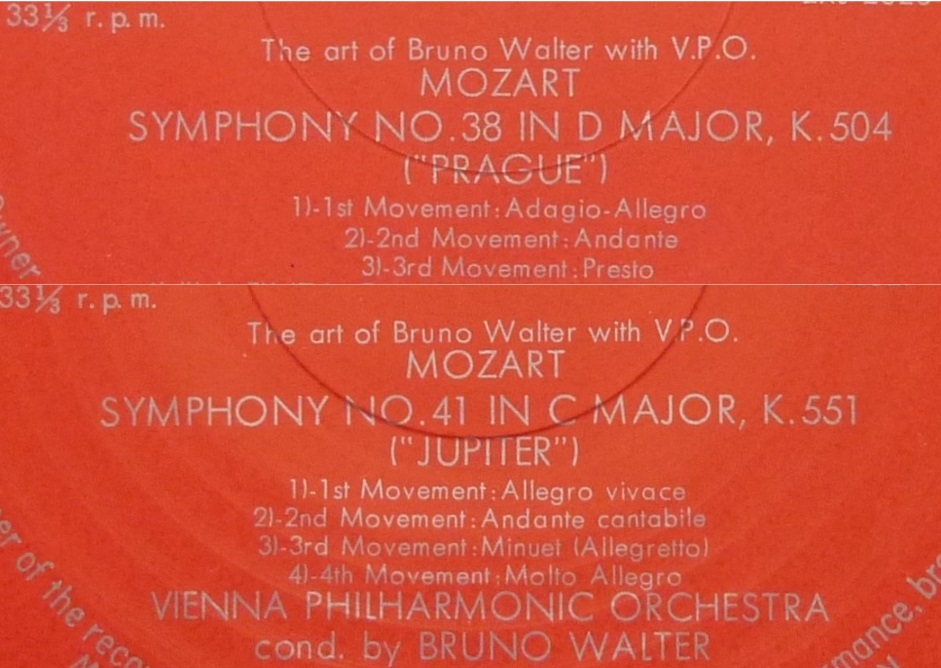
________
Sinfonia Concertante K.364 NYPO John Corigliano & William Lincer Carnegie Hall 10 March 1946 Source: Bande/Tape (origine: disques/transcription discs)
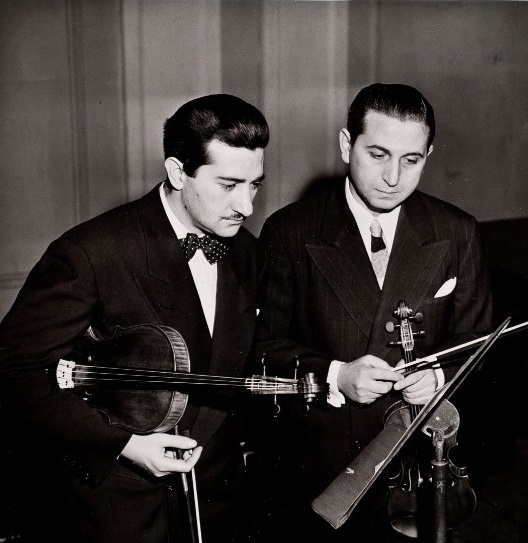
William Lincer & John Corigliano
________
Ces trois enregistrements de Bruno Walter représentent la fin de son activité à Vienne avant la guerre, la Symphonie n°41 accompagnant les 15 et 16 janvier la Neuvième de Mahler au cours de sa dernière série de concerts avant l’Anschluss, ainsi que son unique enregistrement accessible de la Symphonie Concertante pour violon et alto K.364 lors du concert du 10 mars 1946. Il avait déjà dirigé cette œuvre à New York les 5 et 6 mars 1925 avec en solistes Samuel Duskin et Lionel Tertis, et il l’a redonnée les 12 et 13 février 1953 avec Corigliano et Lincer, mais sans retransmission radiophonique à cette occasion. Un enregistrement de concert à Chicago (concert télévisé du 25 janvier 1956 avec John Weicher et Milton Preeves) a été recensé dans une archive privée, mais n’a pas été publié. Le concert du dimanche 10 mars 1946 est particulier en ce sens que son programme (Mozart K364, Brahms Symphonie n°4) est complètement différent de celui des concerts des 7 et 8 mars consacrés à la Passion selon St-Matthieu de Bach, alors qu’en général, le programme radiodiffusé le dimanche reprend en partie le programme de la semaine.
Concernant l’interprétation de la Sinfonia Concertante de Mozart, le critique Noel Straus écrivait: ‘John Corigliano, le concertmaster de l’orchestre, et William Lincer, son premier alto, ont été les solistes de l’opus de Mozart, qui, comme le Brahms, a bénéficié d’une lecture des plus élaborées et des plus élevées. Aucune interprétation ne peut être d’un esprit aussi complètement mozartien que celle qui a été donnée de la Sinfonia Concertante, une oeuvre unique en son genre qui n’a rien perdu de sa fraîcheur juvénile et de son grand attrait au cours des 167 années qui se sont écoulées depuis sa composition. Sous une direction moins, cette composition exquisément façonnée peut facilement dégénérer de la part des deux solistes en une exhibition de virtuosité. Même si une bravoure experte était apportée aux mesures en solo, la musique elle-même et la révélation de sa pleine signification étaient le souci principal de Mr. Walter, et il a montré que c’était possible sans exagérer la composante soliste, avec pour résultat qu’un parfait sens de l’équilibre, rarement obtenu dans cette oeuvre à l’orchestration légère, a été rendu possible. Avec cette manière de faire, la composition a gagné en intimité, et rien n’a été oublié pour projeter le caractère sensible et poétique de son contenu. L’art et la compétence technique de Mr. Corigliano et de Mr. Lincer étaient si complètement en harmonie, leurs sonorités si subtilement intégrées et équilibrées, que leurs jeux formaient remarquablement un tout, et s’inscrivaient en même temps dans le cadre dynamique qui convenait exactement à la fusion avec un accompagnement orchestral finement conçu. Il est difficile d’imaginer un rendu plus éloquent et plus convaincant, ou plus admirable par sa pureté tonale, la beauté de sa texture, par ses couleurs et par son expressivité.’
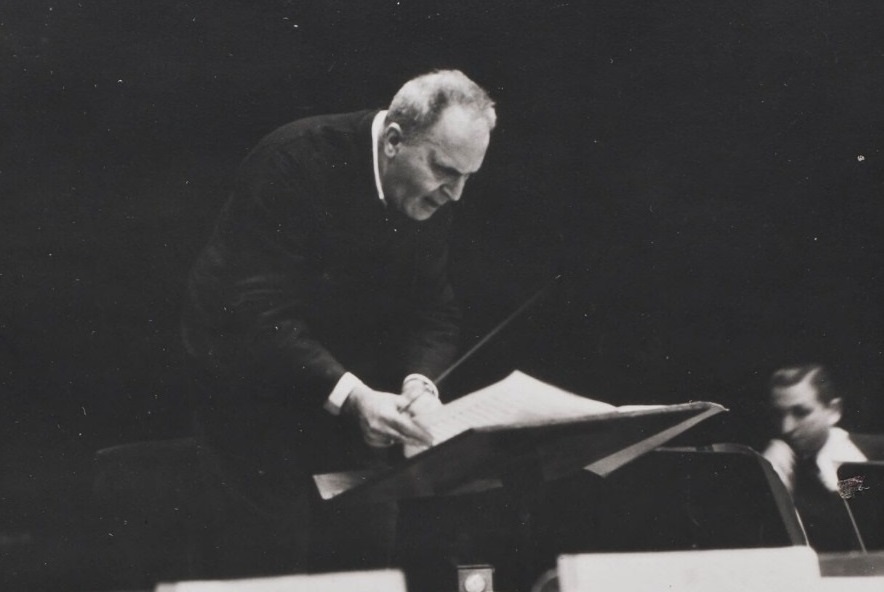
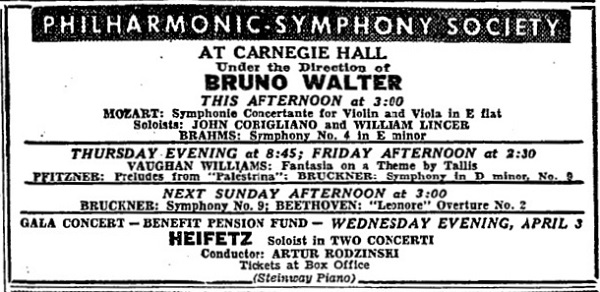
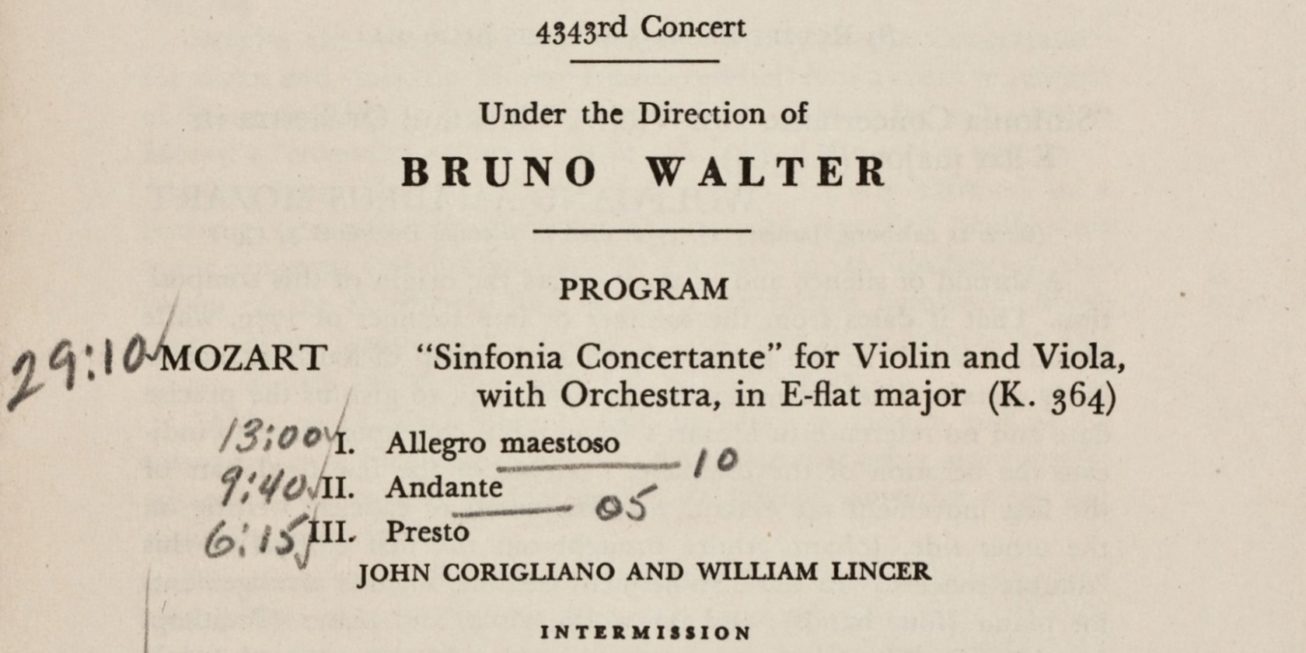
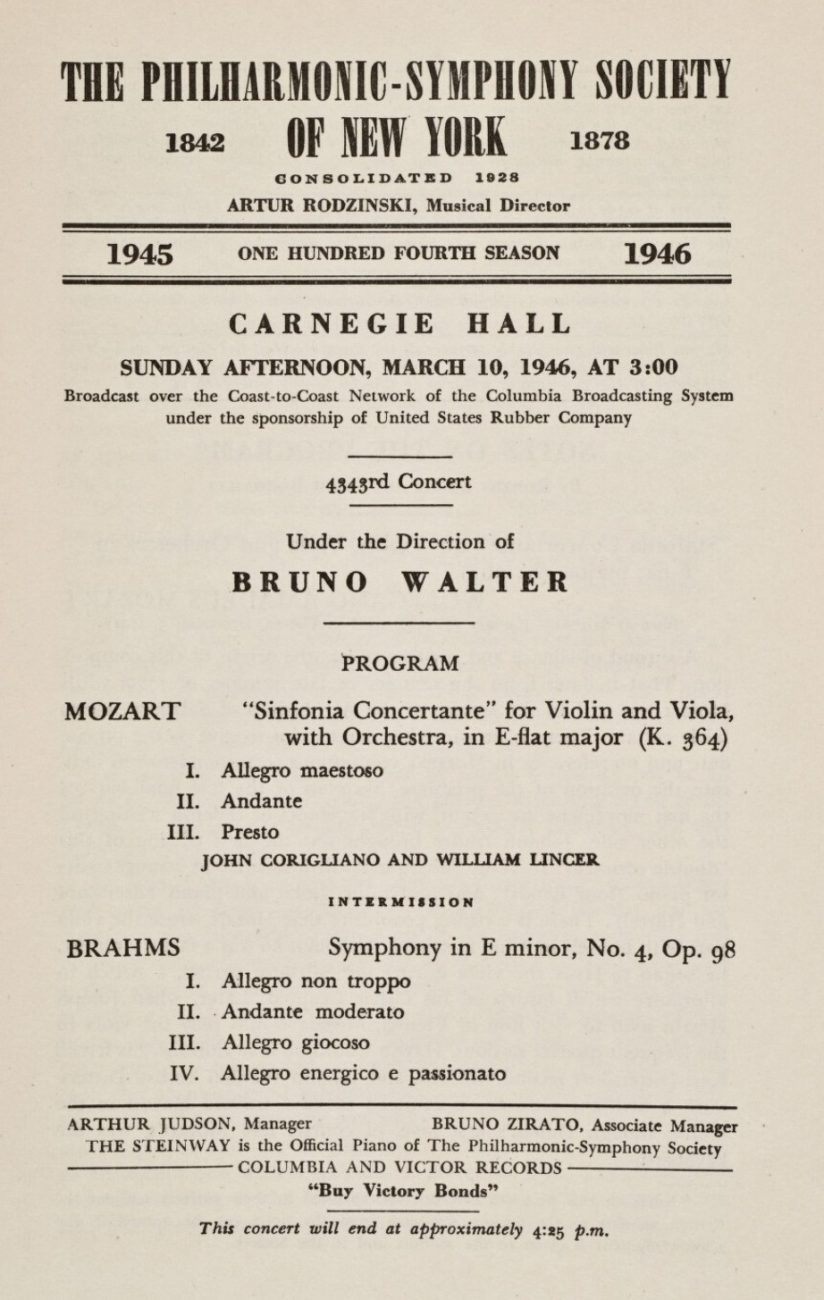
These three Bruno Walter recordings illustrate the end of his pre-war tenure in Vienna, the Symphony n°41 being played on the 15 and 16 January together with the Mahler Ninth during his last series of concerts there before the Anschluss, as well as his only available recording of the Sinfonia Concertante for violin and viola K.364 during the concert of March 10, 1946. He already conducted this work in New York on 5 and 6 March 1925 with Samuel Duskin and Lionel Tertis as soloists, and he performed it again on 12 and 13 February 1953 with Corigliano et Lincer, but without broadcast this time. A concert recording in Chicago (TV concert on 25 January 1956 with John Weicher and Milton Preeves) has been listed in a private archive, but hasn’t been published. The concert of Sunday 10 March 1946 is special in the sense that its program (Mozart K.364, Brahms Symphony n°4) is entirely different from the preceding ones on 7 and 8 March dedicated to Bach’s Passion according to St-Matthew, whereas usually, the program of the Sunday broadcast is partly comprised of works played during the week.
Concerning the performance of the Sinfonia Concertante by Mozart, music critic Noel Straus wrote: ‘John Corigliano, the orchestra’s concertmaster and William Lincer, its first viola, were the soloists in the Mozart opus, which, like the Brahms work, gloried in a reading of a most searching and exalted nature. No performance could be more completely Mozartean in spirit than that given of the Sinfonia Concertante, an unrivaled work of its genre that has lost nothing of its youthful freshness and deep appeal with the passage of the 167 years since its creation. Under less fully comprehending direction, the exquisitely wrought composition easily can become first and foremost an exhibition of virtuosity on the part of the two soloists. But for all the expertness of bravoura brought to the solo measures, the music itself and the revelation of its meaning to the full was the primary consideration with Mr. Walter and this he found possible without overstressing the solo element with the result that a perfect sense of balance, rarely achieved in this lightly orchestrated score, became possible. The composition gained in intimacy through this type of treatment, and nothing was left undone to project the sensitive, poetic character of its content. The artistry and skill of Mr. Corigliano and Mr. Lincer was so perfectly matched, their tone so subtly integrated and equalized, that their playing proved remarkably unified, and at the same time was held in just the right dynamic frame to blend absolutely with the finely considered orchestral support. It is difficult to conceive of a presentation of this work more eloquent and persuasive, or more admirable in tonal purity, beauty of texture, coloring and expressiveness.’




17 réponses sur « Walter – III – Mozart Symphonies n°38 & 41 WPO – Sinfonia Concertante K.364 NYPO John Corigliano & William Lincer »
HD/Hi-Res (24 bits/88 KHz):
https://e.pcloud.link/publink/show?code=kZbTxzZ1NcnQBcxGL42ESOOed2wSBppPQu7
Format CD (16 bits/44 KHz):
https://e.pcloud.link/publink/show?code=kZmTxzZM3jo25t8jbHsKxFV7codI4Xy7Foy
Thank you very much for sharing these lovely Mozart recordings with Bruno Walter.
By the way, if you happen to have the 1955 recording of Mozart’s Divertimento No. 15 in B flat major, K.287 by the Wiener Oktett (Vienna Octet) (with Willi Boskovsky on the first violin) on Decca LP and could post it, it would be greatly appreciated.
Thanks for your comment. Unfortunately, I do not have this LP*. It is a very interesting suggestion, because it is the second recording (from 1978) that Decca has re-issued.
On the other hand, I am contemplating to post the « Haffner » Serenade conducted by Fritz Busch from the Brüder-Busch Gesellschaft LP.
Musically
C&A HD
*MOZART Divertimento No.15 in B flat K287 (K271H)
4-7 Apr 1955 Brahmssaal, Musikverein, Vienna Mono
Producer: Victor Olof & Peter Andry Engineer: Cyril Windebank
Vienna Octet: Josef Veleba (horn), Willi Boskovsky (violin),Günther Breitenbach (viola), Johann Krump (double-bass);
Josef Lackner (horn), Philipp Matheis (violin)
(June 1956) LXT5112; (Dec. 1955) LL1239.
(Japan 1999) POCL4638 = 466 227.2.
It’s a great pity the Vienna Octet’s Mozart Divertimento No. 15 is not in your collection but many thanks anyway for replying to my enquiry and I must express my greatest appreciations again for all the wonderful gems you have shared on your blog. I look tremendously forward to Fritz Busch’s recording of Mozart’s « Haffner » Serenade and future posts from you.
Good news! i have found a LP of this recording in reasonably good condition.
It is a great find. The performance is just marvellous!
It will be the next post.
I thank you as well for these classic, inspired Mozart performances in such expert transfers!
Thank You for these performances 🙂
Many thanks for all these.
Am I correct in assuming that John Corigliano here was the father of the composer of the same name?
Yes, you are right!
Dear C&A, could You please give some detail to the « (origine: disques/transcription discs) »? What does it actually mean? The tape is not coming from the Sinfonia radio broadcast?
Dear MPT,
This means that the broadcast was recorded on single-copy discs (called « transcription discs » in the US), and that these rather fragile discs that get worn after only a few playings were dubbed on a tape for their preservation. My source is thus a (very rare) copy of the tape. Unfortunately, the recording of the Brahms Fourth that was also played at this concert does not seem to have been preserved.
C&A
Thank You for the answer. … but who did the recording to the single-copy discs? And where? Let me specify what I am wondering about: Was the recording to the discs an attempt of the Philharmonic Society to have their material for archive, or somebody’s private initiative? Was it kind of paralel recording to the broadcast, or a recording from broadcast (from radio)? You likely understand what I am asking for? 🙂 In any case, I do, as lilkely anyone coming to Your amazing site, not only the music, but that rich accompanying information as well. Thank You for that.
In 1946, tapes were not available, so Columbia who broadcasted the NYPO concerts could only use these transcription discs (also called lacquers or « acetates ») to make a copy of broadcasts e.g. to allow further broadcasts. However, there was not a real archive policy, so that only some of the concerts have been saved. On this blog, there is the 1948 NYPO performance of the Brahms Concerto n° 2 by Serkin and Mitropoulos.
For Bruno Walter, we have performances from 1941 and later, and Music & Arts has published some of them. The Mozart Sinfonia concertante was published only on LP by The Bruno Walter Society (BWS 523) from the same tape.
Private sources also exist , namely recordings made in the 50’s by music lovers on early tape recorders.
In the 50’s there were also discs cut by the AFRS (Armed Forces Radio Service) for their own re-broadcasts of concerts.
Now I see 🙂 thank You for such comprehensive answer.
Huh, I lost a word « enjoy » in the previous message 😀 sorry.
Received with thanks!
C&A
Mille mercis !